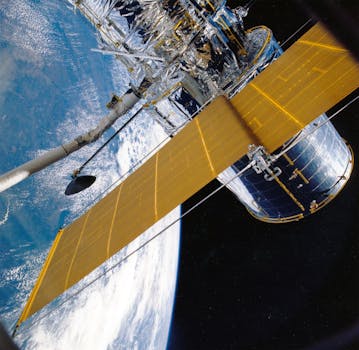The Rise of Mega-Constellations: Latest Updates in Satellite Telecommunications

The Rise of Mega-Constellations: Latest Updates in Satellite Telecommunications
The Focus Keyword Mega-Constellations is transforming the satellite telecommunications industry with the launch of thousands of satellites into low Earth orbit to provide global internet connectivity. This new era of space technology is being driven by companies such as SpaceX, Amazon, and OneWeb, which are investing heavily in the development of mega-constellations. These constellations are designed to provide high-speed, low-latency internet connectivity to remote and underserved areas around the world.
The rise of mega-constellations is not without its challenges, however. One of the main concerns is the potential for increased space debris in low Earth orbit, which could pose a risk to operational satellites and other space-based assets. Additionally, there are concerns about the impact of mega-constellations on the night sky, with some astronomers warning that the increased number of satellites could interfere with astronomical observations.
History of Mega-Constellations
The concept of mega-constellations has been around for several decades, but it wasn’t until the launch of the first satellites in the 1990s that the idea began to take shape. The first mega-constellation was the Iridium satellite system, which was launched in the late 1990s and consisted of 66 satellites in low Earth orbit. However, the system was not commercially successful, and it was eventually sold to a new company, which has since expanded the constellation to over 70 satellites.
In recent years, there has been a renewed interest in mega-constellations, with several companies launching new satellite systems. One of the most notable is SpaceX’s Starlink constellation, which is planned to consist of over 40,000 satellites in low Earth orbit. The constellation is designed to provide high-speed, low-latency internet connectivity to remote and underserved areas around the world, and it has already launched over 1,000 satellites into orbit.
Benefits and Challenges of Mega-Constellations
The benefits of mega-constellations are numerous, with the potential to provide high-speed, low-latency internet connectivity to remote and underserved areas around the world. This could have a significant impact on the global economy, with the potential to increase access to education, healthcare, and other essential services. Additionally, mega-constellations could provide a new platform for scientific research, with the potential to study the Earth’s climate, weather patterns, and other phenomena in greater detail.
However, there are also several challenges associated with mega-constellations. One of the main concerns is the potential for increased space debris in low Earth orbit, which could pose a risk to operational satellites and other space-based assets. Additionally, there are concerns about the impact of mega-constellations on the night sky, with some astronomers warning that the increased number of satellites could interfere with astronomical observations.
Conclusion
The rise of mega-constellations is revolutionizing the satellite telecommunications industry, with the potential to provide high-speed, low-latency internet connectivity to remote and underserved areas around the world. While there are several challenges associated with mega-constellations, the benefits are numerous, and it is likely that these systems will play a major role in shaping the future of space technology.



